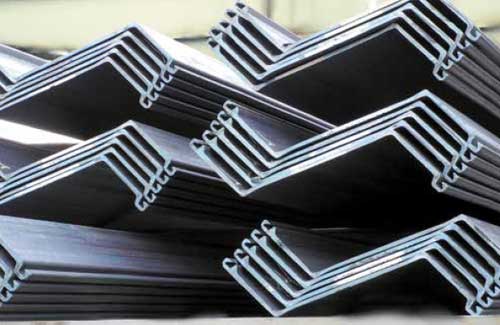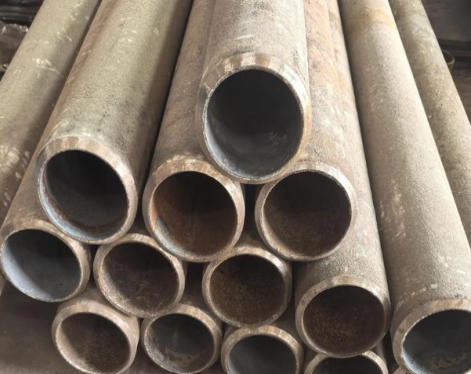Steel sheet pile is a steel structure with linkage devices on the edges, and the linkage devices can be freely combined to form a continuous and tight retaining soil or water retaining wall. Commonly used steel sheet pile models: U-shaped, Z-shaped, L-shaped. This article mainly describes the use of Z type steel sheet piles.
Z-shaped steel sheet piles are made of steel plates that are cold-formed into a Z-shape. Its cross-sectional shape is Z-shaped and has a certain stiffness and bearing capacity. The length of Z-shaped steel sheet piles can be adjusted as needed, usually 6-12 meters.
Z-shaped steel sheet pile is a common form of steel sheet pile. Its cross-section is Z-shaped and has good load-bearing capacity and stiffness. Z-shaped steel sheet piles are suitable for strata with relatively hard soil and certain supporting capabilities, such as gravel soil, clay, etc. During the construction process, Z-shaped steel sheet piles can be installed by vibration or impact to form a stable support structure. Due to the particularity of its cross-sectional shape, Z-shaped steel sheet piles have high bending and shear resistance and are suitable for excavation of deeper foundation pits.

Z-shaped steel sheet piles are sunk with a vibrating pile driver, which has fast construction speed and better pile pulling effect. Compared with the impact pile driver, the construction noise is small, it is not easy to damage the pile top, the operation is simple, and there is no smoke generated by diesel or steam hammer construction. The principle of the vibration pile driver is to transmit the vertical vibration generated by the machine to the pile body, reducing the resistance around the Z-shaped steel sheet pile, which is beneficial to the penetration of the sheet pile.
Z-shaped steel sheet piles are widely used in automobiles, railway vehicles, shelves, electrical cabinets, highway guardrails, building steel structures, containers, transmission towers, steel sheet piles, cable bridges, agricultural machinery, furniture, vegetable greenhouses, pipe supports and other fields.
Z Type Sheet Piles vs U Type Sheet Piles:
On the one hand, Type Z is used in deep-wall construction to provide more durable building support and a stronger foundation. Z-type sheet piles are effective sheet piles. Therefore, they are often used in cantilevered and strapped systems.
On the other hand, U-shaped sheet piles are very similar to Z-shaped steel sheet piles. The difference is their interlocking mechanism. U-shaped sheet piles interlock between adjacent sheet piles. It is located at the edge of each unit. Z-shaped sheet piles have an extra piece of steel protruding out, which helps increase their bending strength. Compared with U-shaped sheet piles, Z-shaped sheet piles have better bending resistance.
Both Z-shaped and U-shaped sheet piles are mainly used to strengthen dams and river banks. They are strong enough to help strengthen structures that must withstand constant pressure from one or both sides. They can also be used to create containment barriers for tighter, more specific protective measures. Another application for these sheet piles is as a sound barrier. This is accomplished when you attach sound-absorbing material to the front of the pile.
Z-type sheet piles are used more often than U-type sheet piles. Z-type sheet piles have a greater modulus, which makes them a better choice for intermediate piles in tubular and HZ composite walls. Since the specific position of the interlocking device is symmetrical on both sides of its neutral axis, Z-shaped sheet piles can also be used to form webs. Due to their similarity, U-shaped steel sheet piles are often considered to be Z-shaped sheet piles. However, U-shaped steel sheet piles can be used in temporary retaining walls, cutoff walls, embankments and bank protection projects.
Z-shaped steel sheet piles are made of steel plates that are cold-formed into a Z-shape. Its cross-sectional shape is Z-shaped and has a certain stiffness and bearing capacity. The length of Z-shaped steel sheet piles can be adjusted as needed, usually 6-12 meters.
Z-shaped steel sheet pile is a common form of steel sheet pile. Its cross-section is Z-shaped and has good load-bearing capacity and stiffness. Z-shaped steel sheet piles are suitable for strata with relatively hard soil and certain supporting capabilities, such as gravel soil, clay, etc. During the construction process, Z-shaped steel sheet piles can be installed by vibration or impact to form a stable support structure. Due to the particularity of its cross-sectional shape, Z-shaped steel sheet piles have high bending and shear resistance and are suitable for excavation of deeper foundation pits.

Z-shaped steel sheet piles are sunk with a vibrating pile driver, which has fast construction speed and better pile pulling effect. Compared with the impact pile driver, the construction noise is small, it is not easy to damage the pile top, the operation is simple, and there is no smoke generated by diesel or steam hammer construction. The principle of the vibration pile driver is to transmit the vertical vibration generated by the machine to the pile body, reducing the resistance around the Z-shaped steel sheet pile, which is beneficial to the penetration of the sheet pile.
Z-shaped steel sheet piles are widely used in automobiles, railway vehicles, shelves, electrical cabinets, highway guardrails, building steel structures, containers, transmission towers, steel sheet piles, cable bridges, agricultural machinery, furniture, vegetable greenhouses, pipe supports and other fields.
Z Type Sheet Piles vs U Type Sheet Piles:
On the one hand, Type Z is used in deep-wall construction to provide more durable building support and a stronger foundation. Z-type sheet piles are effective sheet piles. Therefore, they are often used in cantilevered and strapped systems.
On the other hand, U-shaped sheet piles are very similar to Z-shaped steel sheet piles. The difference is their interlocking mechanism. U-shaped sheet piles interlock between adjacent sheet piles. It is located at the edge of each unit. Z-shaped sheet piles have an extra piece of steel protruding out, which helps increase their bending strength. Compared with U-shaped sheet piles, Z-shaped sheet piles have better bending resistance.
Both Z-shaped and U-shaped sheet piles are mainly used to strengthen dams and river banks. They are strong enough to help strengthen structures that must withstand constant pressure from one or both sides. They can also be used to create containment barriers for tighter, more specific protective measures. Another application for these sheet piles is as a sound barrier. This is accomplished when you attach sound-absorbing material to the front of the pile.
Z-type sheet piles are used more often than U-type sheet piles. Z-type sheet piles have a greater modulus, which makes them a better choice for intermediate piles in tubular and HZ composite walls. Since the specific position of the interlocking device is symmetrical on both sides of its neutral axis, Z-shaped sheet piles can also be used to form webs. Due to their similarity, U-shaped steel sheet piles are often considered to be Z-shaped sheet piles. However, U-shaped steel sheet piles can be used in temporary retaining walls, cutoff walls, embankments and bank protection projects.









